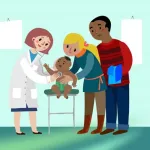Patients with achalasia typically present with progressive dysphagia to both solids and liquids, regurgitation of undigested food, chest pain, and weight loss. The diagnosis is often confirmed through esophageal manometry, which shows absent peristalsis and elevated LES pressure, and barium swallow studies, which reveal a dilated esophagus with a narrowed gastroesophageal junction (bird-beak appearance).
Case presentation Achalasia is associated with an increased risk of esophageal squamous cell carcinoma (SCC) and, less commonly, esophageal adenocarcinoma. Several studies have highlighted this elevated risk, noting that chronic inflammation and food stasis in the esophagus lead to prolonged irritation and inflammation, which predispose the esophageal mucosa to malignant transformation. Additionally, the altered esophageal environment caused by food stasis can result in changes to the microbiota, further contributing to carcinogenesis. Furthermore, the risk of esophageal cancer increases with the duration of achalasia, with patients who have had the condition for over 10 years being at particularly higher risk.
Case 1 A 53-year-old male with a history of achalasia presented in January 2022 for treatment of progressive dysphagia to both solids and liquids, which had been ongoing for approximately two years. His symptoms included regurgitation of undigested food, occasional chest discomfort, and unintentional weight loss of 4 kg over the previous six months. Diagnostic esophagogram and high-resolution manometry confirmed the diagnosis of type II achalasia, with absent esophageal peristalsis and incomplete relaxation of the lower esophageal sphincter. He underwent peroral endoscopic myotomy (POEM) for symptom relief.
Initially, the patient reported improvement in dysphagia symptoms, with an ability to tolerate both solid and liquid food without difficulty. However, by April 2022, he developed significant gastroesophageal reflux disease symptoms, characterized by frequent heartburn, acid regurgitation, and occasional epigastric pain. A proton pump inhibitor was prescribed, and lifestyle modifications were advised, but his reflux symptoms persisted, although somewhat controlled with medication.
In May 2024, during a routine follow-up, the patient reported worsening reflux and the new onset of retrosternal discomfort, along with a recurrence of mild dysphagia. Physical examination was unremarkable, but given the recurrence of symptoms, an upper gastrointestinal endoscopy was performed. The endoscopy revealed a friable, ulcerated lesion located 25 cm from the incisors, which was suspected to be malignant. Biopsy specimens were obtained from the lesion.
Histopathological analysis confirmed the presence of esophageal squamous cell carcinoma (Fig. 1). The lesion was staged using endoscopic ultrasound and computed tomography scans, which revealed local infiltration but no distant metastases. Additional laboratory findings, including a complete blood count, liver function tests, and tumor markers (e.g., carcinoembryonic antigen, SCC), were within normal limits, except for a slightly elevated SCC antigen level. Positron emission tomography was planned for further evaluation.
This case highlights the potential long-term risk of esophageal cancer following POEM in patients with achalasia, especially in the context of chronic reflux. Early recognition and surveillance in high-risk patients may be crucial for timely intervention. Further therapeutic options, including surgical resection, chemotherapy, and radiation therapy, are under consideration for this patient, depending on the staging results.
Case 2 A 51-year-old female with a known history of achalasia presented with progressive dysphagia and intermittent retrosternal pain, particularly when consuming solid foods, over the past year. She had previously experienced episodes of regurgitation and occasional heartburn, but these symptoms had become more pronounced in recent months. Her medical history was otherwise unremarkable, with no prior history of gastroesophageal reflux disease or family history of malignancy.
On physical examination, the patient was in good general condition, with no significant weight loss or other systemic symptoms. Laboratory investigations, including a complete blood count, basic metabolic panel, and liver function tests, were within normal limits. Due to the progressive nature of her symptoms, an upper gastrointestinal endoscopy was performed.
Endoscopy revealed an esophageal lesion located approximately 25 cm from the incisors, appearing as a raised, irregular mucosal area with mild friability. Biopsies were taken from the lesion for further pathological evaluation.
Histopathological examination of the biopsy specimens revealed high-grade intraepithelial neoplasia. Immunohistochemical staining was performed to further characterize the lesion, and strong nuclear positivity for P53 was observed in approximately 85% of the cells, indicating a high likelihood of tumor suppressor gene mutation. The Ki-67 index showed high expression, with a labeling index of 95%, suggesting rapid cell turnover and aggressive cellular proliferation (Fig. 2). No evidence of invasive carcinoma was identified at this stage, and the lesion was confined to the mucosal layers, consistent with high-grade dysplasia.
Given the high-risk pathological features, the endoscopic ultrasound was performed to assess the depth of invasion. No submucosal invasion was detected, and there was no involvement of regional lymph nodes. A computed tomography scan of the chest and abdomen showed no signs of distant metastasis.
This case illustrates the potential progression of achalasia to premalignant lesions, as demonstrated by the presence of high-grade intraepithelial neoplasia. The strong P53 positivity and elevated Ki-67 index further underscore the aggressive nature of this dysplastic lesion. Close surveillance and timely intervention, including endoscopic or surgical resection, are being considered to prevent progression to invasive esophageal carcinoma.
Conclusions Achalasia significantly increases the risk of esophageal cancer, particularly squamous cell carcinoma. The chronic inflammation and food stasis associated with achalasia are major contributing factors to this heightened risk. Effective management of achalasia, combined with vigilant surveillance for early signs of cancer, is essential in reducing the morbidity and mortality associated with this condition. Future research should focus on identifying the molecular mechanisms linking achalasia to esophageal cancer and developing targeted therapies to prevent malignant transformation.
Full text
https://www.xiahepublishing.com/2835-3315/CSP-2024-00005S
The study was recently published in the Cancer Screening and Prevention.
Cancer Screening and Prevention (CSP) publishes high-quality research and review articles related to cancer screening and prevention. It aims to provide a platform for studies that develop innovative and creative strategies and precise models for screening, early detection, and prevention of various cancers. Studies on the integration of precision cancer prevention multiomics where cancer screening, early detection and prevention regimens can precisely reflect the risk of cancer from dissected genomic and environmental parameters are particularly welcome.
Follow us on X: @xiahepublishing
Follow us on LinkedIn: Xia & He Publishing Inc.
END








